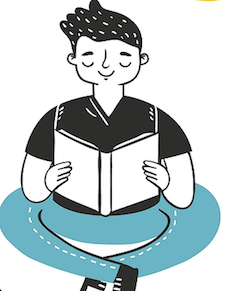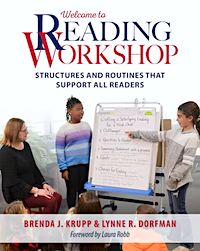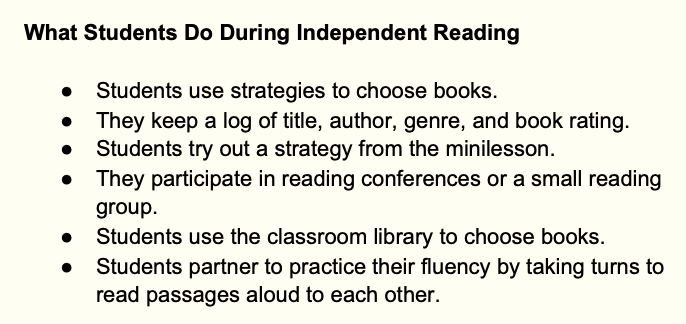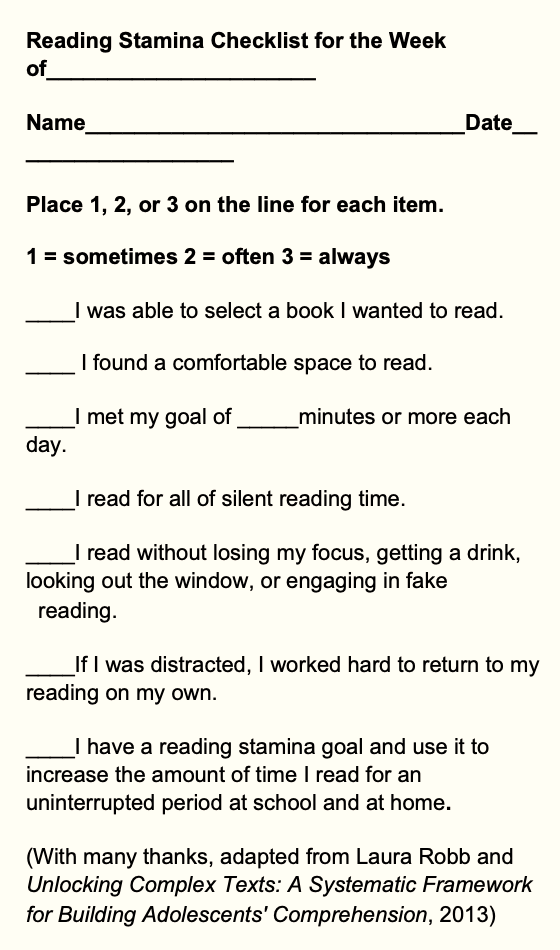Independent Reading Helps Build Endurance
Brenda Krupp and Lynne Dorfman are regular MiddleWeb contributors and co-authors of the new Stenhouse book, Welcome to Reading Workshop: Structures and Routines That Support All Readers (2023).
By Lynne R. Dorfman & Brenda Krupp
Why is independent reading time so important for our students? It sets the stage for students to become immersed in the joy of reading.
When we give students time to read a book they have chosen, time to practice skills and strategies that have been taught, time to talk about books and reading with their teacher, we help them build reading stamina and endurance as they learn to read for pleasure and for intellectual growth.
Allyn and Morrell tell us, “Reading is a great equalizer that has the power to break down the typical barriers to education, those invisible walls built around coveted zip codes and elite institutions.” (2016, 18).
If we want all our students to be successful in finding the time to read daily, we need to give them this time in our reading blocks in school. This routine helps students develop positive attitudes about reading through a wide range of interesting choices that increase motivation and engagement for reading. It also will give students a chance to build their stamina and endurance for the volume of reading that will be required in secondary and college classrooms.
Stamina and Endurance Lead to Reading Success
Stamina is our ability to do something or “carry on” for a long period of time. Stamina builds strength. Stamina can apply to many things we do, such as exercise, playing a musical instrument, developing skills and moves as a ballerina, solving complex mathematical equations, or painting.

When students lack stamina, reading becomes a frustrating and unpleasant experience, so students tend to read as little as possible, jumping from one book to another, even engaging in “fake reading.” Today, reading is a life skill needed for college and career success, as well as for the joy that a personal reading life brings. According to Jean-Jacques Rousseau, to be able to endure is the first lesson a child should learn because it’s the one they will most need to know.
Too often, students give up when required to read longer and more difficult texts. Some upper elementary and middle school children admit they have not read many books (or even one) from cover to cover. How can we best create a culture for reading longer, more difficult texts that require attention, dedication to the task at hand, and finding a smart place to read in order to concentrate and stay focused?
Independent Reading Time Makes a Difference!
According to the International Literacy Association, “…independent reading must occur each day for at least 15 minutes. Without this frequency and duration, students may not develop appropriate stamina. As little as 15 minutes of in-school reading has a profound impact; students who read independently for that amount of time significantly increased their reading performance, with more profound gains for below-average readers.” (Literacy Leadership Brief: The Power and Promise of Read Alouds and Independent Reading, International Literacy Association, 2018, pg. 5)
Many reading experts including Richard Allington, past-president of ILA and noted researcher (2002, 742) note that “Extensive reading is critical to the development of reading proficiency.” We all want our readers to use this independent reading time in school to the best of their ability. That means they need to learn to read without being distracted or without distracting others.

During independent reading, students learn to be flexible, trying out new strategies they’ve acquired through new minilessons, reading conferences, and end-of-workshop final reflections. In order to develop the necessary stamina and endurance for the volume of reading required in upper elementary school grades, middle school, and beyond, students need to choose books that they are able to read with relative ease in independent reading time during the reading workshop.
This means students should be able to decode most words in the book correctly. In this situation, students should avoid using books that are too difficult to read alone. Focusing on the task at hand, students begin to develop a reading habit that can be practiced outside of the school day and help them engage in reading articles, chapters, and other assigned readings across the content areas.
A Time to Practice

In the beginning of the school year, set a timer for a shorter period of time, perhaps ten to fifteen minutes, and increase the time for sustained silent reading over the next several months to twenty or thirty minutes if possible. It is a good idea to occasionally follow this time with a discussion about stamina and endurance – what works to build these strengths and what can work against them.
Are you easily distracted? Can you stay in the moment and avoid trips to the bathroom, talking with a classmate, staring out the window, or daydreaming? Have you chosen the right book to keep you interested in reading? The importance of teaching students how to “bookshop” is crucial. Choice creates engagement and nurtures students’ desire to read.
An up-to-date classroom library will enable students to make good choices. It’s important to survey students’ interests as an ongoing practice for growing your classroom library. Knowing when to abandon a book and choose a new one is also important (see p.98-99, Welcome to Reading Workshop: Structures and Routines That Support All Readers).
Becoming a Wise Reader Takes Time and Practice

A wise reader always pays attention to the text, often stopping to think…what have I just read? What do I understand? What am I wondering about? Wise readers continually evaluate their own thinking to see if it makes sense. A wise reader realizes and understands that reading is not about reading words…it’s about making meaning!
Final Thoughts
In Good Choice!: Supporting Independent Reading and Response K-6, author and educator Tony Stead reminds us that when we create “a time for independent reading from the onset of the school year, children not only build up stamina for reading, but also see it as an important and pleasurable component of their daily lives (2008, 5).”
To some extent, our students learn to read by reading. As students grow stamina and endurance, teachers offer praise and small celebrations. Not all of your students will improve their reading stamina at the same rate. Some students need more than a school year to be able to read for long periods of time. That’s why you may need to partner with teachers across grade levels to give students the gift of time.
With access to wonderful classroom and school libraries and daily time to read books they self-select to read, students will grow as readers and develop a lifelong reading habit.

Dr. Lynne R. Dorfman is on the leadership team for the West Chester Writing Project. Lynne has been an adjunct professor for Arcadia University for the past 24 years and loves interacting with graduate students. She enjoys her work as a co-editor of PA Reads: Journal of Keystone State Literacy Association and is past president of Eta, a chapter of Alpha Delta Kappa. Lynne is a co-author of many books including Grammar Matters: Lessons, Tips, and Conversations; Using Mentor Texts, K-6; A Closer Look: Learning More About Our Students with Formative Assessment, K-6; and Welcome to Writing Workshop with Stacey Shubitz.
Brenda Krupp served as a third-grade teacher at Franconia Elementary School for over 25 years and holds a Master’s degree in Curriculum & Instruction from Penn State University. She also served as teacher-on-assignment, coaching teachers in reading and writing practices. Brenda has been Co-Director for the PA Writing & Literature Project and co-facilitated the summer invitational Writing Institute, a six-credit graduate level course. She has presented at NCTE, PAWLPdays, and other local conferences. Brenda has also facilitated various courses in the teaching of writing and consulted with school districts on teaching writing (K-5).







































Independent reading time is crucial for students as it fosters a love for reading and builds stamina and endurance. Encouraging students to read books of their choice, practice skills, and engage in discussions about their reading helps develop positive attitudes toward reading. Building reading stamina is essential, especially in a digital age where students are accustomed to shorter interactions. Establishing a routine of independent reading in schools contributes to students’ success in handling longer and more complex texts, preparing them for academic challenges and a lifelong love of reading. The article emphasizes the significance of creating a culture that values and supports independent reading.